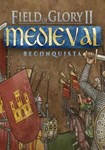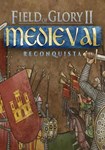DLC Field of Glory II: Medieval - Reconquista KEY🔑
Positive responses: 0
Negative responses: 0
Sold: 0
Refunds: 0
Seller: vokrugmira
information about the seller and its items
Loyalty discount! If the total amount of your purchases from the seller more than:
| $50 | the discount is | 2% |
| $100 | the discount is | 3% |
$4.96
💥Instant 24/7 product delivery immediately after purchase!💥 The product is delivered automatically even if we are offline.
❗️Please pay attention to the product specifications before purchasing❗️
🌟 (DLC) Field of Glory II: Medieval - Reconquista 🌟 This product is an addition to the game. To activate it, you need to have the main game.
Specifications:
Type: Activation Key
Activation region: Russia and the CIS
Client for the game: Steam
Localization: Completely in English
Platform: PC
Year: 2021
---------
Description:
Feudalism did not have such a dominant influence in Spain and Italy as in Northwestern Europe. Both of these lands had unique factors influencing the conduct of the war. In 1050, more than half of the Iberian Peninsula was under the rule of Islamic states, an area known as Andalusia. After the collapse of the Umayyad Caliphate in 1031, Andalusia was divided into several small Muslim states known as the Taifa Emirates. The Typhs often fought among themselves, which is why they could not resist the larger Christian kingdom of Castile, which was created in 1037 with the absorption of the Kingdom of Leon. This was the true beginning of the Christian Reconquista, which would end only in 1492. To stop the Christian attack, in 1086 the Taif Emir of Seville invited the Murabite Berbers of North Africa to enter Spain. This did not work out as planned for the Taif, as after defeating the Castilians at the Battle of Sagrajas, the Murabites quickly incorporated most of the Taif emirates into their empire. The Murabit Empire was invaded in 1147 by the rival Berber sect of the Almohads. These events were a serious setback for the Spanish Christian kingdoms, but they recovered to gain a great victory over the Almohads at Las Navas de Tolosa in 1212, which forever broke the power of Muslims in Spain. Soon only the emirate of Granada remained, but already as a vassal of Castile. During this period, there were also frequent clashes between states of the same religion, and Muslim and Christian warriors often did not hesitate to serve the princes of another religion. In Northern Italy, large cities have always tried to maintain a certain degree of independence and often fought fiercely against attempts by the Holy Roman Emperor to impose his authority over them. They became increasingly wealthy in trade, and by the end of the 11th century their urban militias had become the backbone of the Italian armies, eclipsing the role of the feudal knights. In 1176, the northern Italian cities formed the Lombard League and won a great victory over Emperor Frederick I Barbarossa at the Battle of Legnano. It was part of the Guelph and Ghibelline wars. The Papacy and the Empire initially quarreled over who had the right to appoint church officials, this was known as the "Investiture Conflict". The Ghibellines were the ones who supported the Holy Roman Emperor, while the Guelphs were the party supporting the Pope. Despite the fact that the investiture dispute was resolved in 1122, the conflict between the papacy and the Empire, the Guelphs and the Ghibellines lasted for hundreds of years. In Southern Italy, the Normans rose from humble mercenaries to conquer all of southern Italy and establish the great kingdom of Sicily after conquering the island from the Arabs. After the line of Norman kings ended when William II died without male heirs, the throne passed to the German imperial Hohenstaufen dynasty. In 1266, the Pope called on Charles of Anjou to attack the Hohenstaufen and, after winning the Battle of Benevento, seized the kingdom for himself. Functions: Another 20 nations and factions spanning Spain, Italy and North Africa from 1040 to 1270 AD. These include Andalusians, Almohads, Arabs, Aragonese, Byzantine Catapanate of Italy, Castilians/Leonese, Catalans, Granadines, Hafsids, Italian Guelphs, Italian Ghibellines, Italo-Normans, Lombards, Marinids, Murabites, Navarrese, Papal Kingdom,
No feedback yet










